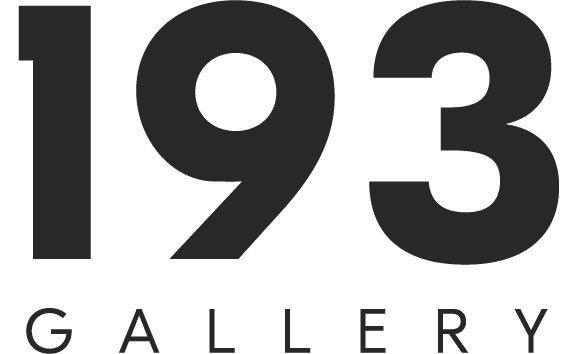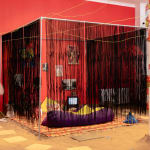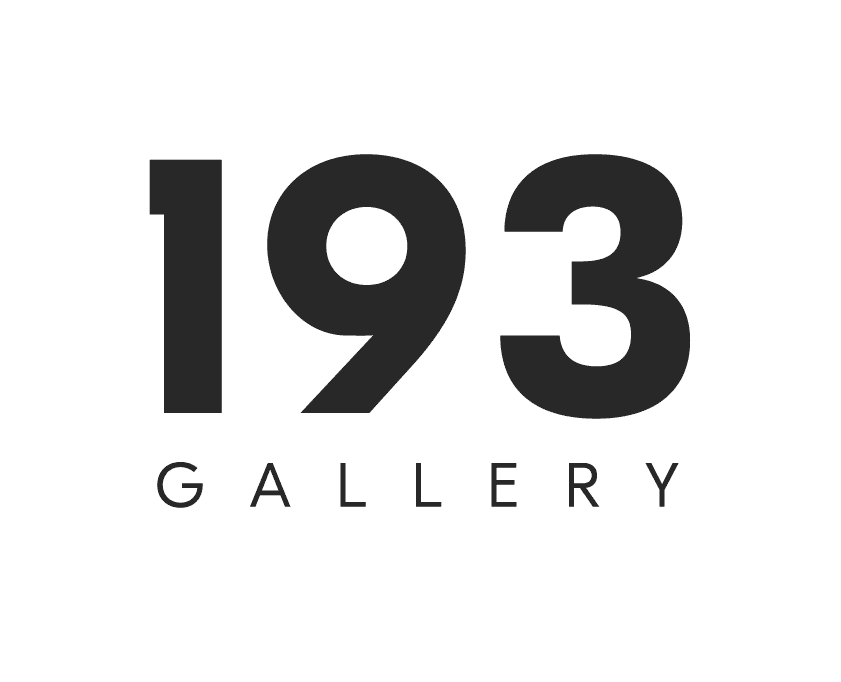

Roxane Mbanga France / Cameroun / Guadeloupe, b. 1996
Salon #1 is a modular domestic environment designed to be assembled, taken down, and reinstalled across different exhibition settings. Its frame is built from metal scaffolding—typically used on construction sites—which outlines an open yet clearly defined space. Hanging from the structure are long black synthetic braids that act like curtains: they partially shield the space without fully enclosing it, creating a threshold rather than a wall.
The floor is covered with a square raffia mat. At the center, a minimal arrangement: a pouf, a few cushions, a lamp, books, and an old CRT television. The surrounding walls are filled with reworked visuals—risographs, silkscreens, altered drawings, and scanned photographs—showing scenes from everyday life in Africa. Often dismissed as mundane or viewed through an exoticizing lens, these images are reassembled here to reclaim their value, presence, and complexity.
The television plays Naked Underneath, or How to Use Clothing as a Tool for Self-Affirmation, a video work preceded by a short prelude that questions how Black bodies are seen and represented. Launched in Lagos in 2019 and later developed in Dakar in 2020, the series invites women to wear a boubou—or kaba—directly over their bare skin. Historically imposed during colonial rule to cover African women’s bodies, the boubou has since been reclaimed in domestic life as a garment associated with comfort and privacy. Here, it becomes a space for embodied reinterpretation—a way to inhabit nudity from within. In the video, the women walk through public space while their voiceovers reflect on what the experience brought up for them: moments of vulnerability, empowerment, and transformation.
A fan slowly circulates the air, setting the braids and hanging posters in motion. The braids aren’t just decorative—they reference the ongoing scrutiny directed at natural Black hair: its texture, authenticity, and whether it can be touched. The curtain becomes a metaphorical boundary between intimacy and exposure.
A woven basket holds a selection of books pulled from the artist’s own library—folktales, essays, critical theory. The salon is imagined as a space for quiet thought, where the personal and political meet. Visitors are invited to sit, read, rest, and observe.
The atmosphere is intentionally dense. Incense fills the space, and the heat is turned up high. The warmth slows the body, creating a sense of weight and stillness. The fan’s gentle breeze offers a kind of rhythm, softening the space and adding a physical dimension to its movement.
During its first presentation at the Rietveld Academie, the installation was activated by a live performance by Roxane Mbanga, who positioned herself inside the structure while viewers looked on from the outside. In that context, the metal frame and braided curtains resembled a cage—underscoring how Black bodies, and especially the bodies of Black women, are so often observed, constrained, or projected onto in public space.
Salon #1 est un espace domestique modulaire, conçu pour être monté, démonté et déplacé selon les contextes d’exposition. Sa structure, composée de tubes métalliques habituellement utilisés sur les chantiers de construction, délimite une pièce ouverte mais clairement définie. Des rideaux de tresses noires sont suspendus à l’armature : ils isolent sans cloisonner et laissent passer les regards.
Le sol est recouvert d’une natte carrée. Au centre, un mobilier minimal : un pouf, quelques coussins, une lampe, des livres et une télévision à tube cathodique. Les murs sont recouverts d’un ensemble d’images — risographies, sérigraphies, dessins retravaillés, scans photographiques — représentant des scènes du quotidien en Afrique. Ces images, souvent perçues comme banales ou, à l’inverse, exotiques selon le regard porté sur elles, sont ici réassemblées pour être regardées autrement, dans un cadre qui leur redonne une place active.
La télévision diffuse la vidéo Naked Underneath ou Comment utiliser le vêtement pour s’affirmer, précédée d’un prélude qui interroge les dynamiques du regard, en particulier celui porté sur les corps noirs. Initiée à Lagos en 2019 et poursuivie à Dakar en 2020, cette série propose à des femmes de porter un boubou/kaba — vêtement traditionnel ouest-africain — directement sur leur peau nue. Cette nudité invisible, vécue de l’intérieur, devient un outil d’affirmation. Filmées en train de marcher dans l’espace public, les participantes livrent en voix off leurs ressentis, ce que ce geste a révélé ou transformé.
Un ventilateur fait lentement bouger les tresses suspendues et les affiches, introduisant un mouvement discret dans l’espace. Les tresses ne sont pas décoratives : elles renvoient à des questions récurrentes posées sur le cheveu crépu — sa texture, sa "véracité", la possibilité ou non de le toucher. Le rideau devient ainsi une forme de seuil entre espace intime et exposition publique.
Un panier tissé contient une sélection de livres — contes, essais, récits critiques — issus de la bibliothèque de l’artiste. Le salon est conçu comme un lieu de lecture et de réflexion, où se rencontrent expérience personnelle et pensée politique. On peut s’y asseoir, lire, écouter, observer.
L’atmosphère est marquée par l’odeur de l’encens et par la chaleur volontairement accentuée de la pièce. L’air devient dense, presque étouffant. Cette chaleur invite le corps à ralentir. Le ventilateur apporte un souffle régulier qui module cette sensation et participe à la mise en mouvement de l’espace.
Lors de sa première exposition à la Rietveld Academie, l’installation a été activée par une performance de Roxane Mbanga, présente à l’intérieur de la structure, observée depuis l’extérieur. Les tubes métalliques et les rideaux de tresses évoquent alors une cage, soulignant la manière dont les corps noirs — et en particulier les corps féminins — sont souvent scrutés, enfermés ou projetés dans l’espace public.



